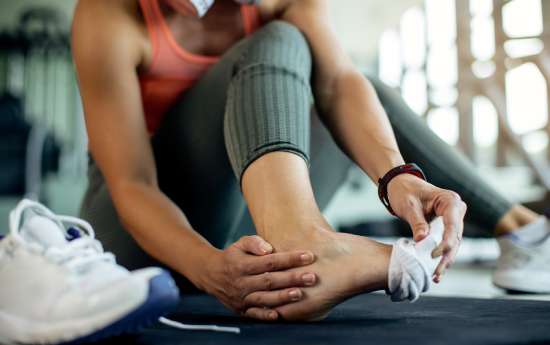
Ankle sprains are one of the most common musculoskeletal injuries, affecting athletes, children, and adults alike. Complications of this seemingly innocuous injury include recurrent ankle instability, osteochondral injuries and ankle arthritis with resulting long term disability. Understanding their causes, prevention strategies, and treatment options is crucial for recovery and long-term health. This article aims to educate patients and the general public about ankle sprains, including historical perspectives and recent advances in treatment.
Causes of Ankle Sprains
Ankle sprains occur when the ligaments that support the ankle stretch beyond their limits and tear. The ankle is supported by the broad groups of ligaments – The lateral complex (on the outer side of the ankle), the medial complex (inner side) and the syndesmotic or interosseous ligaments. Amongst these the medial and the syndesmotic ligaments are stronger than the lateral group. The position and deviation of the foot at the time of injury influences the ligaments that are injured.
The ligaments commonly affected are the anterior talofibular ligament (ATFL) and the calcaneofibular ligament both of which belong to the lateral group. The severity of the sprain depends upon the mechanism of injury (high versus low energy), the position of the foot and the rotational force transferred to the foot & ankle. Lower grade injuries only cause microscopic tears to the stabilising ligaments while higher grade injuries can lead to significant tendon disruption or even fractures of the ankle/foot. Syndesmotic injuries are a type of high ankle sprain with significant energy trauma that disrupts the distal tibiofibular interosseus ligaments.
Ankle sprains can happen in various scenarios:
– Sports Injuries: Sudden movements, jumps, or changes in direction can lead to a sprain.
– Falls: Landing awkwardly on your foot can overstretch the ligaments.
– Uneven Surfaces:Walking or running on uneven terrain increases the risk.
– Inappropriate Footwear:Wearing shoes that do not support the foot properly can lead to instability.
Treatment and Therapy
An X-ray of the ankle and the foot is often required to assess for bony break if any.
A. Initial treatment for ankle sprains follows the P.R.I.C.E. protocol:
– Protection: Immobilisation to protect the injured ligaments in the initial period. Prolonged immobilisation is usually unnecessary unless there is any associated fracture.
– Rest: Avoid activities that cause pain, swelling, or discomfort generally for 72 hours.
– Ice: Apply ice packs to reduce swelling and numb pain.
– Compression: Use an elastic bandage, lace-up ankle support or semi-rigid inflatable brace to compress the ankle.
– Elevation: Elevate the ankle above heart level to reduce swelling for the initial 24-48 hours.
B. Medications: Oral tablets help control the pain and swelling enabling faster recovery.
Mild sprains usually recover by around 2 weeks. They may need some physical rehabilitation exercises to strengthen the muscles.
For moderate to severe sprains, additional treatments may include:
– Physical Therapy: Early functional rehab program with focus on restoration, regaining range of motion, proprioception and neuromuscular training. The strengthening exercises are commenced once swelling reduces and the patient has full range of ankle movement. Strengthening the lateral muscle group (peroneal muscles) is beneficial to prevent recurrent sprains.
– Surgery: Rarely, surgery may be needed to repair torn ligaments. Surgery is more commonly required for higher grade injuries including syndesmotic injuries that result in complete disruption of the ankle joint stability.
Prevention Measures
Preventing ankle sprains involves several strategies:
– Strengthening and muscle conditioning exercises: Strengthen the muscles around the ankle with exercises such as calf raises, toe walks, and balance drills.
– Stretching:Regularly stretch the Achilles tendon and calf muscles.
– Proper Footwear: Choose supportive shoes that fit well, especially during physical activities.
– Bracing or Taping: Consider ankle braces or taping for added support during sports or high-risk activities.
– Warm-Up and Cool-Down: Always warm up before exercise and cool down afterwards to prepare and relax the muscles.
Footwear Modifications
Proper footwear is essential in both prevention and recovery:
– Supportive Shoes: Choose shoes with good arch support and a stable base.
– Custom Orthotics: Custom-made shoe inserts can provide additional support and correct foot mechanics.
– High-Top Shoes: For sports, high-top shoes may offer extra ankle support.
Newer Advances in Ankle Sprain Treatment
Modern technology has enabled development of cutting edge techniques that help prevent and facilitate treatment. Some of these include:-
– Regenerative Medicine: Techniques such as platelet-rich plasma injection (PRP) therapy aim to enhance the body’s natural healing processes. These injections are given in the vicinity of the injured ligament to accelerate healing.
– Biomechanical Analysis: Advanced imaging and analysis of individual gait patterns help customize rehabilitation programs.
– Wearable Technology: Devices that monitor activity and provide feedback on gait and movement can aid in preventing re-injury.
– Improved Surgical Techniques: Minimally invasive procedures and better postoperative care have improved outcomes for those needing surgery.
Authoritative Guidelines
For more detailed information, consider the following resources:
– American Academy of Orthopaedic Surgeons (AAOS): [Ankle Sprains] (https://orthoinfo.aaos.org/en/diseases–conditions/sprained-ankle/)
– National Institute for Health and Care Excellence (NICE): [Sprains and Strains] (https://www.nice.org.uk/guidance/conditions-and-diseases/musculoskeletal-conditions/sprains-and-strains)
– Mayo Clinic: [Ankle Sprain] (https://www.mayoclinic.org/diseases-conditions/ankle-sprain/symptoms-causes/syc-20371593)
Conclusion
The understanding and treatment of ankle sprains have evolved significantly over time. Ancient treatments included rudimentary splints and herbal poultices. During the 20th century, advances in sports medicine led to more structured rehabilitation protocols. The introduction of arthroscopy allowed for minimally invasive surgical repairs of ligament injuries. Today, evidence-based practices and guidelines from organizations like the American Academy of Orthopaedic Surgeons (AAOS) and the National Institute for Health and Care Excellence (NICE) guide effective treatment.
By staying informed and proactive, patients can effectively manage ankle sprains and maintain an active, healthy lifestyle. For personalized advice and treatment, always consult with a healthcare professional.
*Disclaimer: This document is for information purposes only and does not substitute professional medical advice. Always consult with a healthcare provider for an accurate diagnosis and treatment plan.


